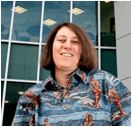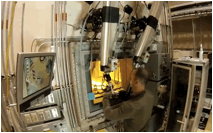Friday, May 24, 2013
The solace of quantum
Jane Hordholt. LANL photo.
Jane Nordholt of Los Alamos National Laboratory has just demonstrated how a pocket-sized QKD transmitter called the QKarD can secure signals sent over public data networks to control smart electricity grids.
Smart grids balance demand and supply so that electricity can be distributed more efficiently. This requires constant monitoring of the voltage, current and frequency of the grid in lots of different places—and the rapid transmission of the results to control centres. That transmission, however, also needs to be secure in case someone malicious wants to bring the system down. (Full Story)
Los Alamos team ready for next step on quantum communications project
From left: Glen Peterson, Kevin McCabe, Raymond Newell, Jane Nordholt and Richard Hughes. LANL photo.
Top-secret Los Alamos National Laboratory has not been deliberately keeping a secret about its new hyper-secure information technology. It’s just that the lab’s ongoing quantum communications project, which has already set world records and won important science prizes, has been undergoing another evolution from theory and experimentation to practice. (Full Story)
Cyber attacks to grow as a threat to U.S. energy grid, Los Alamos head says
Director Charlie McMillan displays a QKarD, a device that transmits secure signals. LANL photo.
Cyber attacks, currently a serious threat to the American energy system, are set to become only more substantial in the coming years, said Dr. Charles McMillan, the director of Los Alamos National Laboratory.
“Another area that I’d like to treat as an example is the security issues associated with our critical infrastructure,” McMillan said. “To just give you as sense of scale, in the time that it took me to say the last sentence my external firewalls at Los Alamos were challenged hundreds of times.” (Full Story)
Domestic production of medical isotope Mo-99 moves a step closer
The Isotope Production Facility. LANL photo.
Los Alamos National Laboratory announced that for the first time, irradiated uranium fuel has been recycled and reused for molybdenum-99 (Mo-99) production, with virtually no losses in Mo-99 yields or uranium recovery. This demonstrates the viability of the separation process, as well as the potential for environmentally- and cost-friendly fuel recycling. Medical isotope production technology has advanced significantly now that scientists have made key advances in separating Mo-99 from an irradiated, low-enriched uranium (LEU) solution. (Full Story)
Bradbury to honor military personnel
Los Alamos National Laboratory’s Bradbury Science Museum is again partnering with the National Endowment for the Arts, Blue Star Families Foundation and the Department of Defense in the Blue Star Museums program to host active duty military personnel and their families from Memorial Day through Labor Day. (Full Story)
Argonne works for HIV vaccine
Cutting-edge research at UChicago’s Argonne National Laboratory is a potential first step to the development of an HIV vaccine. The research, focused on mapping the development of the CH103 antibody, was a collaborative effort, bringing together analysis conducted at Los Alamos National Laboratory and experiments conducted at Argonne. (Full Story)
Researchers explain magnetic field misbehavior in solar flares: The culprit is turbulence
Solar Storm. NASA image.
An interdisciplinary research team says it has found a key to the mystery. The culprit, the group proposed, is turbulence -- the same sort of violent disorder that can jostle a passenger jet when it occurs in the atmosphere.
Co-authors of the Nature study from Johns Hopkins include Hussein Aluie, from the Department of Applied Mathematics and Statistics; Aluie is also affiliated with the Los Alamos National Laboratory. (Full Story)
Los Alamos begins pumping tests on chromium plume
Well R-50 at Los Alamos National Laboratory has detected chromium at levels which exceed New Mexico standards. LANL photo.
Los Alamos National Laboratory will begin pumping tests this summer at two groundwater monitoring wells located on Lab property within a chromium plume in the regional aquifer.
The purpose of the pumping tests is to refine understanding of the plume properties within the regional aquifer and evaluate the potential for large-scale pumping to remove chromium. (Full Story)
LANL makes strides in cleaning runoff
Engineer Erin English, with Biohabitats, Inc., a firm representing the Communities for Clean Water (CCW), gave the Regional Coalition of LANL Communities a progress report on Los Alamos National Laboratory’s efforts at storm water management. English spoke highly of the LANL storm water team.
“We’ve actually ended up in quite a collaborative process and have found that the LANL folks have gone far above what they had committed to doing as a result of that lawsuit.” (Full Story)
Exascale advocates stand on nuclear stockpiles
While exascale funding hearings are nothing new, yesterday’s appeal struck a different chord, harmonizing with the urgency of ensuring U.S. nuclear capabilities—a note that has been resonating in headlines lately.
From the beginning, this Stewardship and associated Simulation and Computing program pulled in funding—breathing new life into research endeavors at a number of national labs, most notably Sandia, Lawrence Livermore and Los Alamos. (Full Story)
To subscribe to Los Alamos Report, please e-mail listmanager@lanl.gov and include the words subscribe losalamosreport in the body of your email message; to unscubscribe, include unsubscribe losalamosreport.
Please visit us at www.lanl.gov
And follow us on Facebook, Twitter, YouTube, and Flickr

















